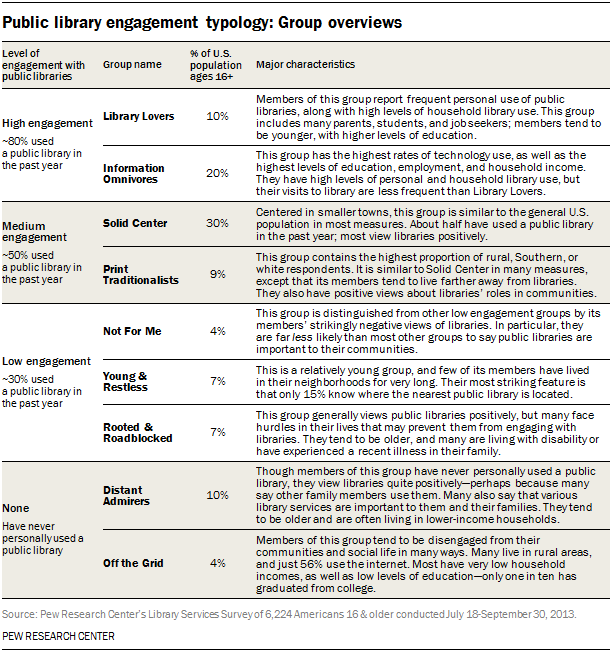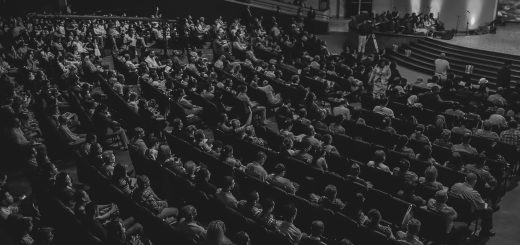“Disruption and Aspiration:” Pew Research Center’s Library Analysis
Hyperlinked Environments & Issues
Choose Your Own Adventure Exploration – Module 6
Topic: Pew & Libraries
For the sake of exploration and curiosity, I turned to the Pew Research articles and reports related to libraries to build a better understanding of the patrons that visit library establishments in the United States. My view of libraries is often skewed by the fact that I serve one consistent demographic: high school teens in a relatively rural, low-income community. However, in the public sphere, library patron demographics are known to ebb and flow. Indeed, Pew researchers (Rainie, 2014) found that 26% of library patrons reported an increase in their library use in the past 5 years, while another 22% stated that their library use declined. With this regular give and take of nearly ¼ of the patrons, it is evident that libraries should regularly survey their users to better understand the demographics they serve, to provide relevant resources and programming, and to be flexible and open-minded with constant change.
Most of the reports referenced herein are nearly 10 years old, so we are definitely due for some new Pew Research data! Nonetheless, the data give us a good glimpse into library users in this age of technology, social media, and e-readers.
Who are the regularly engaged library users?
- The highest engagement: women, median age 44, well-educated (Zickuhr, Purcell, Rainie, 2014)
- The users with the most positive connotation between library and community: women, Hispanic, Black, and low-income (Horrigan, 2015)
- The most common age group: Millennials (Geiger, 2017)
- The biggest reason for engagement: experiencing “key life moments” (Zickuhr, Purcell, Rainie, 2014, p. 4) such as new parenthood, job opportunities, retirement, and more!
- People that are engaged in libraries are typically engaged elsewhere, too; they have “extensive economic, social, technological, and cultural resources” (Zickuhr, Purcell, Rainie, 2014, p. 4).
- An overwhelming majority of library users view themselves as lifelong learners. Those who visit the library/bookmobiles regularly AND those who classify themselves as lifelong learners are more likely to rate the library’s service to the community as “very well” or positive (Rainie, 2016).
The following groups were established in the 2014 Report by Zickuhr, Purcell, & Rainie:

Who are the non-patrons (and non-readers)?
- Non-patrons and those with low engagement include the following demographics: White, men, rural, and low-income (or facing other economic barriers) (Zickuhr, Purcell, Rainie, 2014)
- Non-readers include higher rates of the following demographics: men, high school education (or less), Hispanic, age 50+, low-income, and rural (Gelles-Watnick & Perrin, 2021)
- Non-reader demographic mirrors that of non-patron demographics. Non-patrons do tend to be those with “traditionalist” views of libraries, and it could be that they believe the library only offers books (and therefore, as non-readers, the library wouldn’t be of service to them).
For those who are engaged, what do they want from their libraries?
- Patrons view “libraries as part of the educational ecosystem” (Horrigan, 2015, p. 5)
- Libraries should offer: literacy programs, materials and services for schools/students, technology learning opportunities, services for recent immigrants, services for veterans, and more (see chart below) (Horrigan, 2015).
- The array of services that patrons hope for paints “a complex portrait of disruption and aspiration” (Horrigan, 2015, p. 4), both challenging and bolstering traditional library offerings.
- Older teens and young adults want access to newer technologies, like 3D printers (Rainie, 2014)
- “77% of Americans now think it is ‘very important’ for public libraries to provide free access to computers and the internet to the community” (Zickuhr, 2014); patrons believe that the library is the place for information, no matter the format.
- Patrons still want access to print materials, but they need technology too: “Technology is not so much a substitute for ‘offline’ activities as it is an enhancement tool” (Zickuhr, Purcell, Rainie, 2014, p. 6)

The Takeaways
Although those with the highest engagement are slightly older and more educated, it seems that those that benefit most and have the greatest positive outlook on libraries are patrons who seek learning and opportunity in the library; women (often mothers), Hispanic, Black, and low-income Americans would be detrimentally impacted if they did not have library access. The library serves as a positive hub for the community, connecting patrons with both wants and needs to fulfill their daily lives. While it may be challenging to engage the non-readers and the non-patrons, we can lean into serving those who are engaged in our libraries, and continue to provide relevant, innovative services to those who choose to partake in the wonderful world of libraries.
Resources
From Pew & Libraries (Module 6 – CYOA)
Zickuhr, K., Purcell, K., & Rainie, L. (2014). From distant admirers to library lovers-and beyond.
Zickuhr, K. (2014). Public libraries and technology: From ‘houses of knowledge’ to ‘houses of access.’
Rainie, L. (2014). 10 Facts about Americans and public libraries.
Horrigan, J.B. (2015). Libraries at the crossroads.
Rainie, L. (2016). Libraries and learning.
Geiger, A.. (2017). Millennials are the most likely generation of Americans to use public libraries.
From my own findings:
Gelles-Watnick, R. & Perrin, A. (2021). Who doesn’t read books in America?
Title “Disruption and Aspriation” inspired by Libraries at the crossroads (Horrigan, 2015).




@savannahpolizzi thank you for this. So good to be reminded of everything Pew has done centered on libraries. I really found the typology good to revisit and I think it holds up pretty well. I am wondering how we might serve all of those different folks from the people that love the library to those that might have things that prevent them from visiting the library.